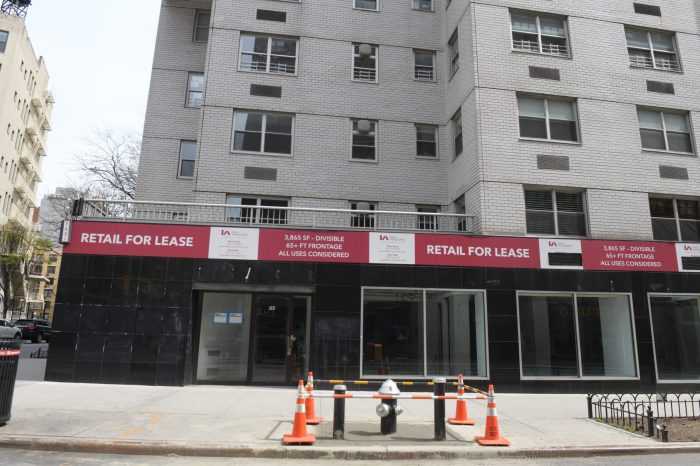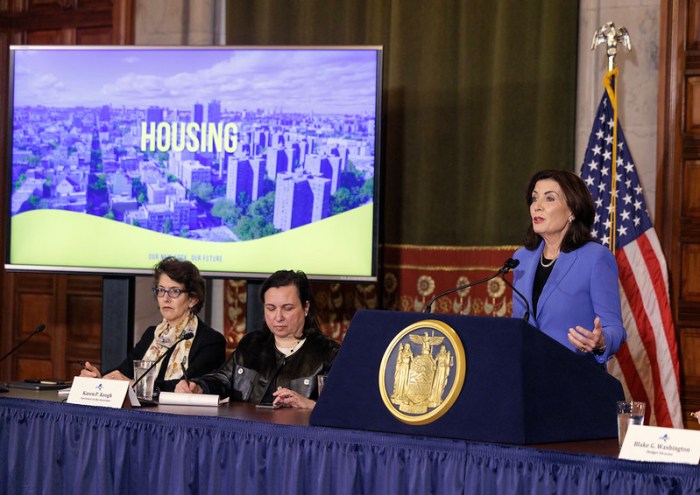
BY LINCOLN ANDERSON | Calling the Elizabeth St. Garden a unique and precious open space in the heart of historic Little Italy, former Parks Commissioner Adrian Benepe last week told The Villager that he opposes a plan for affordable housing on the city-owned site and that the garden should be preserved as permanent parkland.
He’s just the latest current or former public official to come out against the housing plan, joining a growing list of opponents, including Assemblymember Deborah Glick and state Senator Daniel Squadron, as well as the community’s representative voice — Community Board 2.
Despite the mounting resistance, the project is being doggedly pushed by City Councilmember Margaret Chin and the de Blasio administration. With from 60 to 100 apartments for seniors, the building would cost up to $24 million to construct.
Benepe served as the city’s parks commissioner for nearly 11 years under former Mayor Mike Bloomberg. With a year and four months left in Bloomberg’s third term, Benepe left the administration for a job at the Trust for Public Land, where he is the national nonprofit’s senior vice president and director of city park development.
Benepe noted that he was speaking to the newspaper as former New York parks commissioner, not as a representative of T.P.L.
“I think this is an unparalleled opportunity to preserve some open green space in an area that is very populated but sorely lacking space,” he said of the Elizabeth St. Garden.
The national goal of T.P.L., he said, is that every person living in an urban or suburban area have a park, green space, trail or playground within a half-mile — about a 10-minute walk — of where they live. Another group, New Yorkers for Parks, uses a different “metric” of one-quarter mile for how close everyone should be to a park or green space, he noted.
“By either measure, this area of the city is underserved,” Benepe said of the garden, which spans from Elizabeth St. to Mott St. midblock between Spring and Prince Sts.
Creating a permanent park on the site obviously would be easy, since it is already being used that way.
“This is a great way to grab some open space without big acquisition costs — the city already owns it,” he said. “I’ve been there several times. I think it’s a delightful and quirky public space just as is.”
Probably, however, most of the statues and other ornaments currently in the garden would have to be moved out, he offered.
“I would imagine they wouldn’t stay,” he said. “They’re worth money, and there are safety issues.”
Benepe said he also supports the idea of shifting the senior housing project to an alternative, larger city-owned site, at Hudson and Clarkson Sts.
“I am sympathetic to the argument put forward by Tobi Bergman, chairperson of Community Board 2, that there are a lot of better sites in this community board to build affordable housing, such as the water-shaft site over at Hudson and Clarkson Sts.,” Benepe said. “For a long time, that was envisioned as a sub-nominal playing field. But with Pier 40, you don’t need it anymore.”
Whereas the Hudson Square spot is both larger and could be rezoned to allow for even greater height — and five times as many apartments, according to Bergman — the Elizabeth St. location is part of the Special Little Italy District, under which building heights are capped at 75 feet, or seven stories. Plus, Little Italy is simply a densely built historic neighborhood that needs this kind of open space, he noted.
“Yes, affordable housing is important,” Benepe said. “I totally support the idea that affordable housing is important for this administration. But this is not a neighborhood of empty lots that have no housing on them. It’s not just that parks and gardens are nice amenities — they provide all kinds of health benefits. They lower the ambient temperature that can create a heat-island effect. They contribute to physical and mental health. They provide a place for kids to run around in.”
Keeping the garden while building the affordable housing on Hudson St., which can accommodate more units, is a “win-win,” Benepe said.
Housing advocates, however, point to other nearby green spaces, notably DeSalvio Playground and Sara D. Roosevelt Park, arguing that the neighborhood doesn’t lack for open space. But Benepe said it’s apples and oranges.
“DeSalvio is a miniscule park that’s already overburdened by use,” he said. “It really has no grass at all. It’s a sheet of asphalt. Sara Roosevelt Park also has mostly asphalt, and there’s very little that’s natural. You’ve got the community garden and trees and seating areas. But otherwise, it’s basketball courts and soccer fields. It doesn’t offer the oasis that Elizabeth St. Garden is.”
On the other hand, Benepe said, “Elizabeth St. Garden is sort of like a natural space in the city. It’s in a relatively quiet stretch of the block, it lends itself to that feeling.”
He added that while the East Village benefits from an “abundance” of community gardens, this unfortunately isn’t the case in Little Italy and neighborhoods to the west, where there is a dearth of community gardens.
Meanwhile, staking out yet a different position, Gale Brewer, the Manhattan Borough President, in a statement to The Villager last week, said she thinks the future of the garden site doesn’t have to be an either-or situation.
“Gardens and open space versus affordable housing is a false choice — if we’re careful and smart we can have both,” Brewer said. “This site is large enough to accommodate both new affordable housing and significant green space for the community. If we work together, we can strike a balance and get this right.”
But Benepe strongly disagreed that both uses could co-exist at the site.
“No, I don’t think that’s the case,” he said. “It’s a very small site. You’d be shortchanging either one. I think the site is barely large enough for housing. You might be able to have a little sitting area. You would use up most of the site for housing and leave behind a little cul de sac.”
On a recent visit to the garden, Benepe again saw just how much people were enjoying it.
“I often go out bike riding,” he said. “I stopped by. There had just been a concert. It was full of people, kids running around. It’s transformational. You can hear birds. There are butterflies. If it’s filled with housing, it’ll be hotter and you won’t have trees to clean the air.
“So my hope is they’ll take advantage of the opportunity to create more housing on a different site,” he said, “and also create a park in a community that is basically underserved by parks.”
As for whether his position puts him at odds with Bloomberg, his former boss, under whom the housing plan was hatched out of the public eye as part of an add-on to the Seward Park Urban Renewal Area development, he called it a “non-issue.” For starters, Benepe said, the subject wasn’t even on his radar when he was parks commissioner: It was only about two months before he left the administration that local residents even discovered that Elizabeth St. Garden was, in fact, city owned, and have since worked to turn it into a thriving public green space.
“The Bloomberg administration was very park friendly, and believed that you cannot have a good residential neighborhood without parks,” Benepe said, “and as a result, invested a lot in creating and improving and expanding parks.”
At any rate, he said, “It’s three years later. He’s not mayor. I’m not parks commissioner.”
And this is how Adrian Benepe — a committed, lifelong city parks advocate, now national leader on parks — feels about it.

















